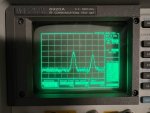I'm perfectively capable of designing and building a more bullet proof filter/LNA, I'm just at the mercy of finding affordable surplus filters. If I were still working I would get one of the big filter companies on the phone and we would design whatever I needed and my company would pay for it. I've had to specify some pretty complicated filters in the past to pull out several ranges of a satellite L-band downlink band to inject things I needed. That filter was not bad at around $2.5k but some of our transmitter combiner diplexer filters ran $500k.
For my personal use I try to find used stuff under $100 and I've been very successful except for this new problem between about 716 and 768MHz. If I can find a good high pass with sharp cutoff at 768Mhz I have a better preamp and no other super high level interferers so it should work fine when that filter shows up someday.
Getting back to your specific BTT Select 78 filter and its potential amount of sales, I don't think it will be a big seller due to its limited frequency range and very specific use. If it works well there will be some amount of people that will buy it then sales will be very sporadic. Just my opinion of course. With 40+ years of jobs designing repeater system front ends, microwave measurement receivers, satellite uplink/downlink systems I've also constantly upgraded my home receive system for amateur and commercial bands. My conclusion is that for most people, a two antenna setup consisting of a Discone for the 118-512Mhz range and a separate mild gain antenna for 700/800/900MHz with high pass/low pass/FM trap on the Discone feeding a high level preamp and 768MHz high pass/cell reject filter feeding a separate preamp on the high freq antenna, then diplexing them together onto one feedline is a winner combination.
If most scanner/professional receiver enthusiasts could see how that performs it would be a huge seller because its what most people could benefit from and it has virtually no frequency restrictions for what people want to do with their scanners or professional receivers. Its not a very tight frequency restrictive product like the BTT Select 78 that only a few might be looking for. Problem for people like me putting together the Holy Grail of receive systems is finding the filters surplus at reasonable prices because its way beyond what most people could ever design and build at home. If someone could make a module that takes in a wide band VHF/UHF antenna like a Discone then a second antenna for 768MHz and higher, with filters that would remove typical high level interference so the whole thing allows great reception of all known public service, commercial, amateur, VHF/UHF aircraft, etc, and put that in a mast mounted box that had a retail price of say under $400, I would buy it and so would a lot of people.
Looks like you are losing some SNR there without a pre-select filter for sure. If you post a block diagram of your Minicircuits setup in another thread, maybe someone here could help out with it. As I said before, there is a pre-select filter before the LNA in the product being discussed in this thread. Is it enough? I don't know yet. I've posted block diagrams, s-parameter plots, and specs. Given the low level of interest in this filter product, I don't think there are many users out there experiencing issues. Having said all off that, I do understand what you are saying. This isn't my first rodeo. If there is interest, I'm willing to re-work the design to fit the need. There are trade-offs. I could re-design to put dual LNAs after each interdigital filter. This would result in the loss of the coupler, plus the loss of the filters before the amp. This would give similar insertion loss specs to the high-cost passive filter mentioned earlier in the thread, while blocking more out-of-band signals from reaching the LNA. Maybe this would be a better way to go for some users if they can afford the loss of sensitivity. I think the bottom line for most people will be: "does it work?".




